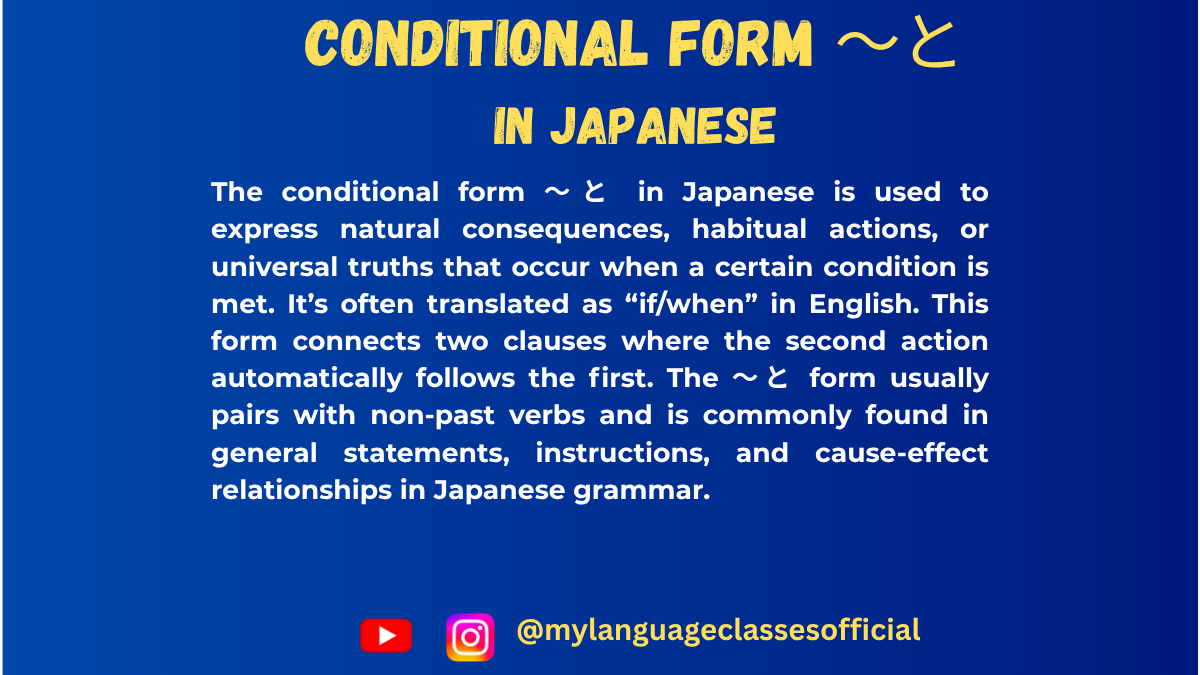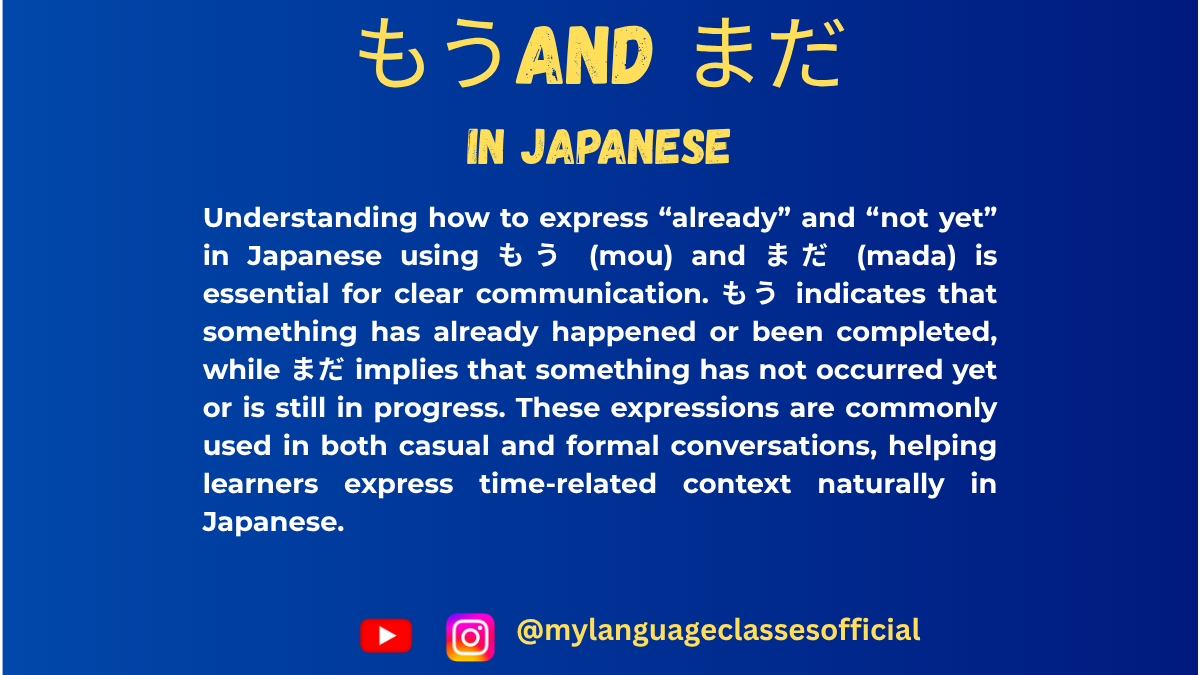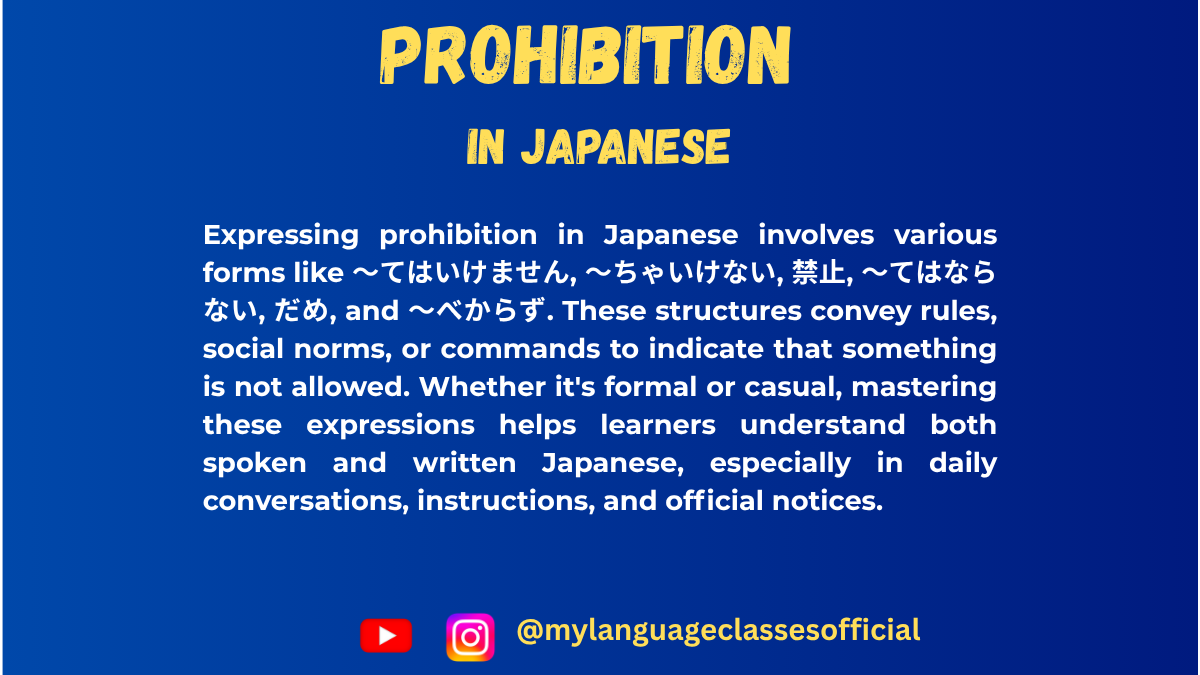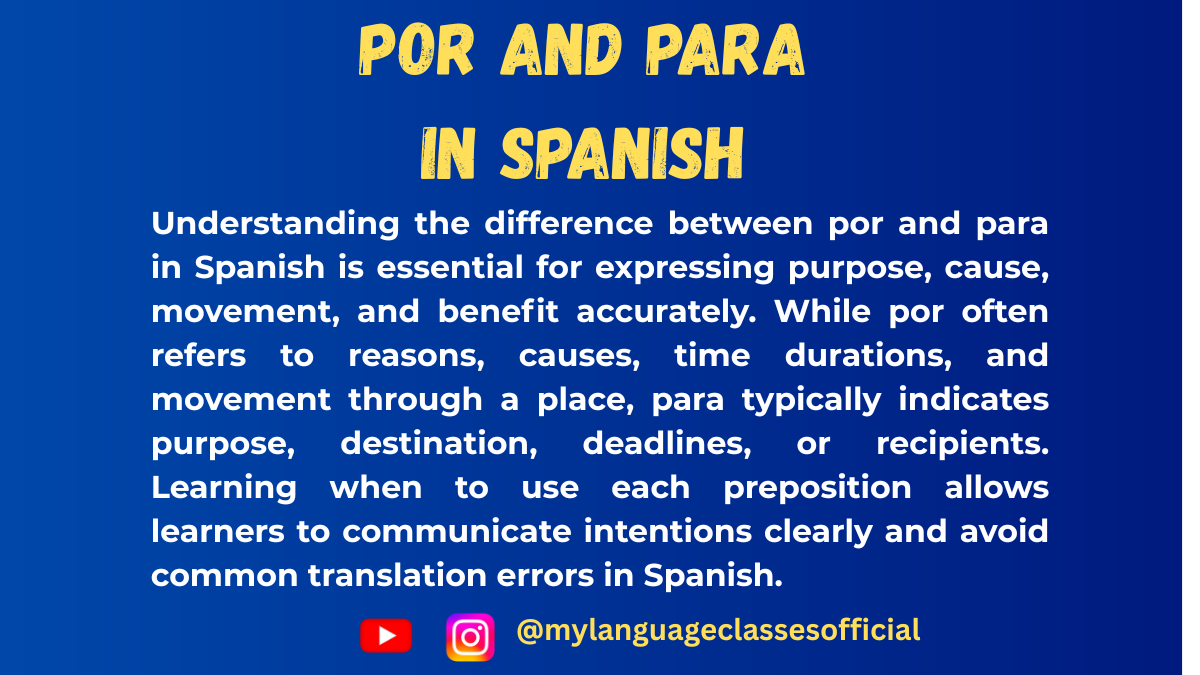Your cart is currently empty!
Tag: politics
-

Using 〜と for Natural Consequence | My Language Classes
Expressing a Natural Consequence in Japanese: 〜と
In Japanese, the particle 〜と has a variety of usages, but it is commonly employed to express natural consequences, conditions, or outcomes. Understanding 〜と is essential for mastering conditional sentences and making logical connections between actions or states.
This blog post will explore the various situations where 〜と is used, providing detailed explanations and examples to help you grasp its nuances.
Primary Uses of 〜と
- Expressing a Natural or Inevitable Consequence When 〜と is used, it implies that the result is a natural or automatic outcome of the preceding action or condition. This is particularly common in scientific or logical statements.Structure:
- Clause A と Clause B
(When Clause A happens, Clause B naturally follows.)
- ボタンを押すと、ドアが開きます。
(When you press the button, the door opens.) - 冬になると、雪が降ります。
(When it becomes winter, it snows.)
- Clause A と Clause B
- Habitual Actions or Repeated Outcomes
〜と can describe a habitual action or repeated phenomenon triggered by a condition.Examples:- 朝起きると、コーヒーを飲みます。
(When I wake up in the morning, I drink coffee.) - 毎回この歌を聞くと、昔を思い出します。
(Every time I hear this song, I remember the past.)
- 朝起きると、コーヒーを飲みます。
- Discoveries or Unexpected Realizations
〜と is used to describe a situation where the speaker discovers something upon performing an action.Examples:- ドアを開けると、猫がいました。
(When I opened the door, there was a cat.) - 山の頂上に着くと、美しい景色が広がっていました。
(When I reached the mountain summit, a beautiful view spread out before me.)
- ドアを開けると、猫がいました。
- Warnings and Hypothetical Negative Outcomes
〜と can express a warning or a negative consequence if a certain action is performed.Examples:- 急がないと、電車に乗り遅れますよ。
(If you don’t hurry, you’ll miss the train.) - そんなことをすると、後で後悔しますよ。
(If you do such a thing, you’ll regret it later.)
- 急がないと、電車に乗り遅れますよ。
- Instructions or Rules in Conditional Situations
In formal contexts, 〜と is used to convey instructions, rules, or expected outcomes.Examples:- お金を入れると、商品が出てきます。
(When you insert money, the product comes out.) - このボタンを押すと、エンジンがスタートします。
(When you press this button, the engine starts.)
- お金を入れると、商品が出てきます。
Key Differences Between 〜と and Other Conditional Particles
- 〜と vs 〜ば
While both can describe conditions, 〜ば focuses more on hypothetical or general conditions, whereas 〜と emphasizes a natural or inevitable result.
Example:- 〜と: 雨が降ると、道が濡れます。
(When it rains, the roads get wet.) - 〜ば: 雨が降れば、試合は中止になるでしょう。
(If it rains, the match will likely be canceled.)
- 〜と: 雨が降ると、道が濡れます。
- 〜と vs 〜たら
〜たら is often used for one-time conditions or events and can handle past-tense conditions, unlike 〜と.
Example:- 〜と: 春になると、桜が咲きます。
(When it becomes spring, cherry blossoms bloom.) - 〜たら: 春になったら、旅行に行きたいです。
(When it becomes spring, I want to travel.)
- 〜と: 春になると、桜が咲きます。
List of Situations Where 〜と Is Used
- Natural or inevitable consequences.
- Habitual actions or consistent outcomes.
- Discoveries or unexpected realizations.
- Warnings or hypothetical negative outcomes.
- Instructions, rules, or predictable results in formal contexts.
Points to Remember About 〜と
- Non-Intentional Clause B:
The second clause (Clause B) must describe something out of the speaker’s control, such as a fact, habitual action, or natural consequence. - No Past-Tense Clause A:
The first clause (Clause A) cannot be in the past tense.
Example:- Incorrect: 彼が来たと、部屋が明るくなった。
- Correct: 彼が来ると、部屋が明るくなった。
(When he comes, the room becomes brighter.)
- Clear Cause-and-Effect Relationship:
There must be a logical and automatic relationship between Clause A and Clause B.
Mastering 〜と will enhance your ability to create logical, fluent sentences in Japanese. By understanding its nuances and contexts, you’ll find it easier to express cause-and-effect relationships and describe habitual or natural outcomes in daily conversation and writing.
If you enjoyed this lesson, be sure to check out more posts like this on my blog at My Language Classes. Don’t forget to subscribe my YouTube channel and follow me on Instagram for the latest language learning tips and lessons. Leave a comment below to share your thoughts, or ask any questions you have about nouns.
Happy learning! 😊
- Expressing a Natural or Inevitable Consequence When 〜と is used, it implies that the result is a natural or automatic outcome of the preceding action or condition. This is particularly common in scientific or logical statements.Structure:
-

How to Say “Already” & “Not Yet” in Japanese もう and まだ | My Language Classes
Expressing “Already” and “Not Yet” in Japanese
When learning Japanese, one of the first challenges is understanding how to express “already” and “not yet.” In English, these concepts are simple, but in Japanese, we rely on two essential words: もう (mou) and まだ (mada). By the end of this post, you’ll master how to use these two expressions correctly and naturally.
1. Understanding もう (“Already”)
The word もう translates to “already” in English and is used to indicate that an action has already been completed or a state has been reached.
Examples of もう in Sentences
- もう食べました。
Mou tabemashita.
“I already ate.” - もう終わりましたか?
Mou owarimashita ka?
“Have you already finished?” - 彼はもう来ました。
Kare wa mou kimashita.
“He has already come.”
Key Point for もう:
- Use it with the past tense of a verb to show completion.
- It often expresses a sense of surprise or confirmation.
2. Understanding まだ (“Not Yet”)
On the other hand, まだ means “not yet” and expresses an action or state that has not happened or is still ongoing.
Examples of まだ in Sentences
- まだ食べていません。
Mada tabete imasen.
“I haven’t eaten yet.” - まだ終わっていない。
Mada owatte inai.
“It’s not finished yet.” - 彼はまだ来ていません。
Kare wa mada kite imasen.
“He hasn’t come yet.”
Key Point for まだ:
- Use it with the negative form of a verb.
- It implies that something is expected to happen or still in progress.
3. Using もう and まだ Together
To create a clear contrast, you can use もう and まだ in conversations:
- もう食べましたか?
Mou tabemashita ka?
“Have you already eaten?”- Answer (Yes): もう食べました。(Mou tabemashita.) – “I already ate.”
- Answer (No): まだ食べていません。(Mada tabete imasen.) – “I haven’t eaten yet.”
This contrast helps clarify whether something has already occurred or is still pending.
4. Common Expressions Using もう and まだ
Here are a few handy expressions that use these words:
- もういいです。 (Mou ii desu.) – “It’s okay now.” / “I’m done.”
- まだまだです。 (Mada mada desu.) – “I still have a long way to go.” (Often used humbly about one’s skills or progress.)
5. Summary: Quick Reference Table
Word Meaning Usage Example もう Already Past/Complete Actions もう行きました。 (Mou ikimashita.) – “I already went.” まだ Not Yet/Still Negative or Ongoing まだ行っていません。 (Mada itte imasen.) – “I haven’t gone yet.”
6. Practice Time!
Try filling in the blanks with もう or まだ:
- ( )宿題を終えましたか? (… shukudai o oemashita ka?)
“Have you finished your homework already?” - いいえ、( )終わっていません。
“No, I haven’t finished yet.”
Answers:
- もう
- まだ
By practicing もう and まだ, you’ll gain confidence in expressing whether something has “already” happened or “not yet.” Keep listening to native speakers and trying these phrases in daily conversation—まだまだ there’s plenty to learn, but you’re already doing great!
What do you think about these tips? Let me know if you もう understand or if you’re まだ unsure—leave a comment below! 😊
If you enjoyed this lesson, be sure to check out more posts like this on my blog at My Language Classes. Don’t forget to subscribe my YouTube channel and follow me on Instagram for the latest language learning tips and lessons. Leave a comment below to share your thoughts, or ask any questions you have about nouns.
Happy learning! 😊
- もう食べました。
-

How to Express Prohibition in Japanese | My Language Classes
Expressing Prohibition in Japanese
If you’re learning Japanese, mastering how to express prohibition (saying what cannot or should not be done) is an essential step toward fluency. Japanese has a rich tapestry of expressions for prohibition, each carrying different nuances based on politeness levels, context, and the strength of the prohibition. In this blog, I’ll guide you through the most common ways to express prohibition in Japanese and help you understand when to use them.
1. ~てはいけません (Te wa ikemasen)
This is one of the most commonly used and polite ways to express prohibition in Japanese. It translates roughly to “You must not…” or “It’s not allowed to…”.
Formation:
Take the te-form of the verb and attach ~てはいけません.
Example:
- ここでたばこを吸ってはいけません。
(Koko de tabako o sutte wa ikemasen.)
“You must not smoke here.”
This phrase is often used in formal situations, such as school rules, workplace guidelines, or signs in public spaces.
2. ~ちゃダメ / ~ちゃいけない (Casual Forms)
In casual settings, Japanese speakers often use ~ちゃダメ or ~ちゃいけない to express prohibition. These are informal contractions of ~てはいけません.
Example:
- ここでゲームしちゃダメだよ。
(Koko de geemu shicha dame da yo.)
“You can’t play games here.” - あそこで走っちゃいけない。
(Asoko de hashiccha ikenai.)
“You must not run over there.”
Use these with close friends, family members, or peers, but avoid them in formal contexts.
3. 禁止 (Kinshi) – The Formal, Written Prohibition
When expressing prohibition in written form, especially on signs or official notices, the word 禁止 (kinshi, meaning “prohibited”) is frequently used.
Example:
- 飲酒禁止 (Inshu kinshi)
“Drinking alcohol is prohibited.” - 駐車禁止 (Chuusha kinshi)
“No parking.”
This construction is direct and impersonal, commonly used in public spaces to state clear rules.
4. ~てはならない (Te wa naranai)
This is a more formal and literary way of expressing prohibition. It is less common in daily conversation but can be seen in legal documents or formal writings.
Example:
- 嘘をついてはならない。
(Uso o tsuite wa naranai.)
“You must not tell lies.”
5. Use of だめ (Dame)
The word だめ (dame) itself means “no good,” “not allowed,” or “forbidden.” It’s highly versatile and can stand alone as an expression of prohibition.
Examples:
- それはだめです。 (Sore wa dame desu.)
“That’s not allowed.” - 今はだめ。 (Ima wa dame.)
“Not now.”
Depending on the tone and situation, だめ can range from strict to soft and conversational.
6. ~べからず (Bekarazu) – Traditional and Strict
This archaic phrase is rarely used in modern conversation but appears in traditional, formal, or poetic contexts.
Example:
- 立ち入りべからず。
(Tachiiri bekarazu.)
“No trespassing.”
It carries an old-fashioned and authoritative tone, reminiscent of samurai-era language.
Choosing the Right Expression
When deciding how to express prohibition in Japanese, consider the following factors:
- Formality: Use ~てはいけません for polite conversations and signs, and ~ちゃダメ for casual settings.
- Authority: Use 禁止 or ~てはならない for official or serious prohibitions.
- Audience: Adapt your language based on whether you’re speaking to a friend, a stranger, or a group.
Practice Makes Perfect!
Understanding prohibition in Japanese is only the first step; using it naturally requires practice. Try creating your own sentences using these structures, and pay attention to how native speakers use them in real life. The more you immerse yourself, the more intuitive these expressions will become.
So, what are you waiting for? Share your practice sentences in the comments, and let’s refine your skills together!
あなたはどの禁止表現をよく使いますか?コメントで教えてください!
(Anata wa dono kinshi hyougen o yoku tsukaimasu ka? Komento de oshiete kudasai!)
Which prohibition expression do you use most often? Let me know in the comments!
If you enjoyed this lesson, be sure to check out more posts like this on my blog at My Language Classes. Don’t forget to subscribe my YouTube channel and follow me on Instagram for the latest language learning tips and lessons. Leave a comment below to share your thoughts, or ask any questions you have about nouns.
Happy learning! 😊
- ここでたばこを吸ってはいけません。
-

Mastering Por and Para in Spanish
One of the trickiest aspects of learning Spanish is understanding the difference between por and para. While they both translate to “for” in English, their meanings and applications differ significantly depending on the context. In this blog post, we’ll dive into their uses, provide practice questions, share tips for mastery, and conclude with insights to deepen your understanding.
The Basics of Por and Para
- Por: Often indicates cause, means, movement, or duration. Think of it as looking back at reasons or processes.
- Para: Focuses on purpose, destination, or goal. It looks forward to outcomes or effects.
Detailed Uses of Por
- Cause or Reason:
Indicates why something happens.- Por qué llegaste tarde? (Why were you late?)
- Llegué tarde por el tráfico. (I was late because of traffic.)
- Movement Through or Around:
Describes movement in a non-finalized way.- Caminamos por el parque. (We walked through the park.)
- Viajaron por Europa. (They traveled around Europe.)
- Means or Method:
Explains how something happens.- Te llamé por teléfono. (I called you by phone.)
- Mandé el paquete por correo. (I sent the package by mail.)
- Duration or Frequency:
Refers to how long or how often something occurs.- Estudié por tres horas. (I studied for three hours.)
- Voy al gimnasio dos veces por semana. (I go to the gym twice a week.)
- Exchange or Substitution:
Describes a trade or replacement.- Pagué veinte dólares por este libro. (I paid twenty dollars for this book.)
- Cambié mi auto viejo por uno nuevo. (I exchanged my old car for a new one.)
- Expressions of Emotion:
Highlights the cause of a feeling.- Tengo mucho respeto por ti. (I have a lot of respect for you.)
- Lo hizo por amor. (He did it out of love.)
- Idiomatic Expressions:
Learn these as set phrases:- Por favor (Please)
- Por supuesto (Of course)
- Por fin (Finally)
Detailed Uses of Para
- Purpose or Goal:
Focuses on the reason behind an action.- Estudio para ser doctor. (I study to become a doctor.)
- Trabajo para mejorar mi vida. (I work to improve my life.)
- Recipient:
Describes who benefits from an action.- Este regalo es para ti. (This gift is for you.)
- Hice este dibujo para mi mamá. (I made this drawing for my mom.)
- Deadlines:
Indicates time limits or expectations.- El proyecto es para mañana. (The project is due tomorrow.)
- Tenemos que estar listos para las 8. (We need to be ready by 8.)
- Destination:
Specifies where something is going.- Vamos para la playa. (We’re heading to the beach.)
- Salgo para Madrid esta noche. (I leave for Madrid tonight.)
- Opinion:
Used to express perspectives or preferences.- Para mí, es una buena idea. (In my opinion, it’s a good idea.)
- Para él, la tarea es difícil. (For him, the homework is hard.)
- Comparison to Standard:
Highlights unusual or unexpected qualities.- Para su edad, es muy madura. (For her age, she is very mature.)
- Para ser lunes, estoy de buen humor. (For a Monday, I’m in a good mood.)
Por vs. Para: Key Differences
- Time:
- Use por for duration (por tres horas – for three hours).
- Use para for deadlines (para mañana – for tomorrow).
- Movement:
- Use por for movement through a place (por el túnel – through the tunnel).
- Use para for destinations (para el hotel – to the hotel).
- Reason vs. Goal:
- Use por for reasons (por el mal tiempo – because of bad weather).
- Use para for goals (para aprender – to learn).
Practice Questions
- Translate:
- I bought this for my friend.
- We’ll be in Spain for two weeks.
- This book is for studying.
- They canceled the party because of the rain.
- Choose the correct preposition:
- Salgo ___ la escuela a las 7. (por/para)
- Hice esto ___ ti. (por/para)
- Gracias ___ venir. (por/para)
- Identify the context of por or para:
- ¿Por qué lo hiciste?
- Estudio para mejorar mi español.
Tips for Mastering Por and Para
- Think Cause vs. Purpose:
- Use por for reasons (past or present causes).
- Use para for goals or effects (future intentions).
- Visualize the Destination:
- Use para when thinking about a final result or destination.
- Memorize Idioms:
- Learn common expressions like por favor and para siempre.
- Practice in Context:
- Try to create sentences using both words to compare their meanings.
- Take Note of Patterns:
- Some verbs are almost always paired with por or para (e.g., gracias por, trabajar para).
Final Thoughts and Conclusion
Understanding the difference between por and para can feel challenging at first, but with practice, the nuances become clearer. Think of por as reflecting reasons, processes, or exchanges, while para points toward goals, outcomes, and destinations. By focusing on their key differences and practicing regularly, you’ll gain confidence in distinguishing them.
Both por and para are indispensable in Spanish, and mastering them will elevate your fluency. Use the practice questions, keep experimenting with sentences, and don’t shy away from making mistakes—learning a language is a journey of trial and discovery.
¡Buena suerte! (Good luck!)
If you enjoyed this lesson, be sure to check out more posts like this on my blog at My Language Classes. Don’t forget to subscribe my YouTube channel and follow me on Instagram for the latest language learning tips and lessons. Leave a comment below to share your thoughts, or ask any questions you have.
Happy learning! 😊
